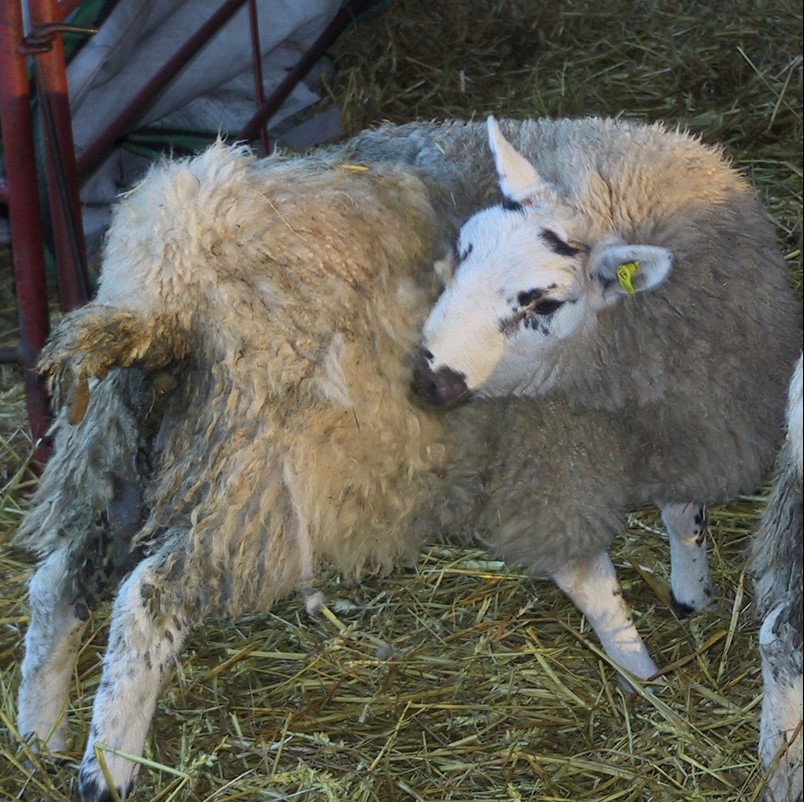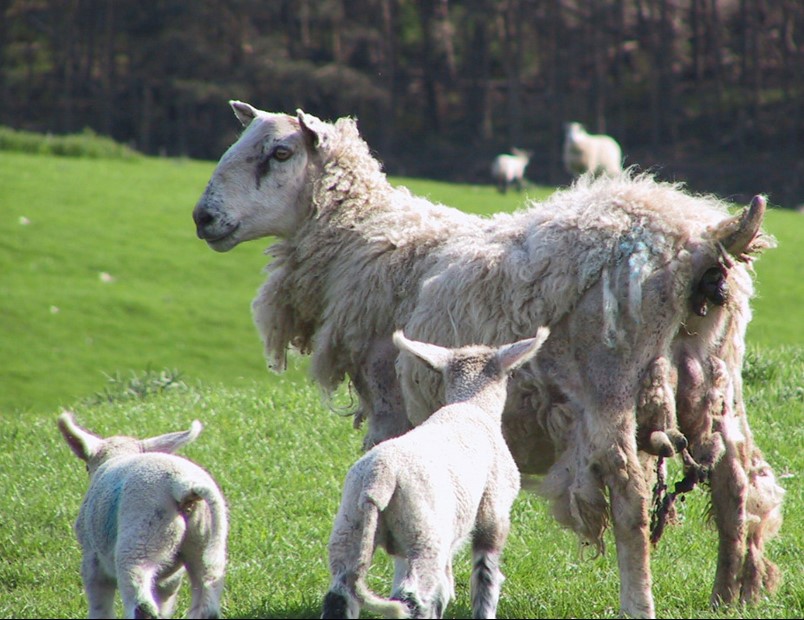Introduction
Sheep scab, caused by the mite Psoroptes ovis leads to major economic losses to the UK flock and impacts sheep welfare. Attempts to control the disease through legislation began in the late 1800s, with compulsory treatment enforced from 1928. By 1992, complete eradication had failed and disease control was deregulated. There had been compulsory notification of 100 cases on UK farms that year. Estimated UK case numbers by 2004 were at 7000, with Wales having the highest prevalence. A 2010 study identified 36% of Welsh sheep farms had a sheep scab outbreak in the previous five years. All studies show areas of persistent infection and sheep on common grazing are twice as likely to be infected as others.
In England and Wales, it remains a legal requirement to treat infected animals and all others in the flock. Local authorities have the power to enforce treatment, prevent movement and control scab on the commons. Sheep scab is a notifiable disease in Northern Ireland. In 2010, Scotland again made the disease notifiable. The Sheep Scab (Scotland) Order 2010 places a legal obligation on any person who has reason to believe that sheep in their possession or care have sheep scab to notify their local Animal & Plant Health Agency (APHA) office as soon as possible. In 2019, Wales announced £5 million funding for a Sheep Scab Eradication Project with details yet to be released.
Sheep scab is spread by any contact with live mites. This is usually through direct sheep-to-sheep contact on commons, via break-ins, at markets or in livestock lorries. Adult mites can survive for up to 17 days in the environment enabling indirect spread via rubbing posts, trees, hedges and fences. Shearing combs and cutters, contaminated clothing, tags of wool or scabs can also harbour and spread mites. In rare cases, scab can infect cattle.
Clinical Signs
The adult mites live in the skin surface where their faeces cause an intense allergic reaction. Females lay eggs which hatch and develop into adults over 10-14 days. They prefer moist areas and cause clinical cases most commonly on fully fleeced animals between September and April. Summer cases are seen usually on fully fleeced or poorly shorn animals. Shorn sheep can carry live mites in the skin folds around the tail head and legs without showing any symptoms. Animals are often seen at different stages of the disease within affected flocks.

Figure 1. Animals at different stages of disease can be seen in the same flock
During the early stages of sheep scab, infestations are not obvious, and animals often appear clinically normal. It can take 40-50 days after infection before signs are seen. There are low mite numbers and very small, virtually undetectable lesions. The first visible signs can be restlessness, rubbing against fence posts, soiled and stained areas of wool, head tossing and loose tags of fleece.

Figure 2. Frequent rubbing against fences and wool tags on the wire may indicate sheep scab or louse infestation

Figure 3. Nibbling the flanks is an early sign of scab and lice
Later stages of infestation with high mite numbers have more obvious clinical signs and the mites spread outwards from the edge of the skin lesions. There is intense rubbing of the shoulders and flanks along the ground or against fences, foot stamping, clawing at the flanks, and biting. Head tossing becomes more excessive and larger areas of wool are lost. There can be open, bleeding wounds and secondary skin infection.

Figure 4. Later stages of sheep scab cause intense itching and biting

Figure 5. As the disease progresses, wool is lost and the skin becomes thickened.

Figure 6. Areas of wool loss with thickened skin become covered with scabs.
The distraction caused by intense itching reduces feeding and there can be a rapid and significant loss in body condition. The loss of fleece and poor nutrition can lead to death through pneumonia or hypothermia. In serious cases, animals will start fitting, particularly when moved.

Figure 7. Scab infestation causes rapid weight loss
Low birthweights and higher mortality occur in lambs born to ewes with sheep scab during pregnancy. Slaughterhouse condemnation of carcasses furthers the economic losses.

Figure 8: Lower birthweights and higher lamb mortality occurs when ewes have scab
Diagnosis
Clinical signs of sheep scab must be investigated to differentiate them particularly from louse infestation. Falsely attributing the clinical signs to lice contributes to the continued spread of scab. If louse infestations are assumed to be sheep scab treatments are used unnecessarily. Sheep scab and lice can occur together.
Other diseases causing itching include bacterial and fly-bite dermatitis, ked and forage mite infestation, rain scald, lumpy wool and scrapie. Wool loss can occur naturally in some breeds or after housing and when lambs climb on their mothers’ backs. It also occurs after serious illnesses such as mastitis or twin lamb disease and after eating poisonous plants such as St. John’s Wort or rape.
Farmers must seek veterinary advice to get a correct diagnosis. To confirm sheep scab, skin scrapes from the edge of a crusting lesion can be examined under a microscope to identify the mite. This test confirms a current infestation and all sheep in the affected group must be treated. Samples of fleece only or skin scrapes from the centre of a lesion from an infected sheep may not contain mites. Examination of the skin by eye is insufficient. It can confirm a louse infestation but does not rule out the presence of scab mites and both can be present on the same animal.

Figure 9. Psoroptes ovis mite under the microscope
In addition to microscopy, sheep can be blood tested for antibodies to sheep scab. The test will not return a positive result for at least two weeks after infection. It is only suitable to test purchased or returning animals which have been isolated for two weeks prior to sampling. Positive results confirm recent exposure to scab mites but the results will remain positive for several months even after effective treatment.
Treatment
There are only two types of treatment available to treat or prevent sheep scab. They are plunge dipping with the organophosphate Diazinon (e.g. Osmonds Gold Fleece Sheep Dip and Paracide 62) or injecting with one of the macrocyclic lactones – moxidectin, doramectin or ivermectin (e.g. Cydectin, Dectomax, Ivomec).
Organophosphate dips are only effective against sheep scab when applied by correctly plunge dipping. They are not effective when used in jets, showers or sprays. Dips kill scab mites within 24 hours and have residual action for several weeks. They provide ongoing protection from re-infection if sheep are returning to the same infected pastures or commons. Dips also control blowfly, lice, keds and ticks.
Operators must have a formal certificate of competence achieved at an approved training course. They must take all the necessary precautions to avoid human and animal health risks and have all the correct permissions or licenses for safe disposal.
Macrocyclic lactones (3-ML) injections when administered correctly can be effective against scab but they do not control blowflies, lice or ticks. The correct dosing procedure for the product must be followed with double dosing for ivermectin and moxidectin 1%. Doramectin and ivermectin have a short residual action and animals are vulnerable to re-infection from other untreated animals or their infected environment (if re-exposed within the 17 day survival period). Sheep treated with these two products may also remain infective for up to 14 days after treatment and must be separated from untreated animals. Moxidectin 2% is injected in the base of the ear and operators must be competent in this technique and aware of the risks.

Figure 10. Adapted from SCOPS: https://www.scops.org.uk/workspace/pdfs/scab-product-options-table_1.pdf
All these injectable drugs are very valuable wormers in the 3-ML class and reliance on them for sheep scab control increases the risk of worm resistance developing.
A study published in 2018 confirmed that sheep scab mites resistant to moxidectin had been found in cases in Wales where treatment had failed. This resistance is likely to pass between all the injectables in the group. Any suspicion of treatment failure must be reported to your vet who can confirm the diagnosis, establish the treatment regime used, report the case to the relevant authorities and provide advice on further treatment.
Prevention
The risks of entry of sheep scab can be significantly reduced through good biosecurity. Maintain a closed flock where possible or ensure effective quarantine and treatment for incoming animals. Ensure all boundaries are stock proof and be aware of the risks of entry on people, clothing and equipment.

Figure 11. Stray sheep can introduce scab – this boundary is not secure.
All incoming sheep including animals from other farms, markets or off grounds may be carrying scab mites even if they have no clinical signs of disease. They must be assumed as carriers, regardless of any assurances of disease freedom or prior treatment from vendors. Even sheep from scab free flocks can be infected at markets, in transport or from contaminated clothing and equipment.

Figure 12. Assume all incoming sheep are infected. Quarantine, test and treat if required.
Farmers must establish and carry out robust biosecurity plans established with their vets as part of the flock health plan. Incoming sheep must be effectively quarantined. The best option to avoid unnecessary scab treatment is to blood test 12 animals in the group for exposure. It is only reliable when samples are collected two weeks after quarantine started.
If blood test results are positive or for untested animals treat the whole group with an effective product according to your health plan and continue to isolate them from the rest of the flock before mixing for the period set out in your health plan. Quarantine options for worms and scab are available from SCOPS: https://www.scops.org.uk/workspace/pdfs/quarantine-options-table.pdf
Common grazers have the highest risk of scab and to gain control all graziers with animals on the same common must cooperate. On established “off-days” it is essential to round up all sheep from the common. This is difficult in practice and some studies estimate 10% of upland sheep can be missed at gathering. Treatment must have residual, preventative action if the animals are returning to the same pasture – OP plunge dip or moxidectin 2%. Animals with short acting treatments could be re-infected from mites in the environment or eggs hatching from other sheep treated similarly. Local authorities have legal powers to ensure animals on affected commons are treated – farmers can report to the local authority if other keepers are failing to control infection.

Figure 13. Untreated sheep on commons pose a risk of re-infection. Use products with residual action for sheep returning to common grazing.


